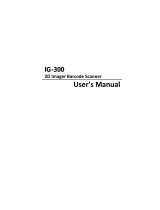
iv
4.2.1. Set prefix................................................................................................ - 82 -
4.2.2. Set suffix ................................................................................................ - 85 -
4.3.1. Direct input keyboard keys .................................................................... - 88 -
4.3.3. Direct input numeric .............................................................................. - 94 -
4.3.4. Direct input character ............................................................................ - 95 -
4.3.5. Direct input lower case character .......................................................... - 97 -
4.3.6. Direct input control character ................................................................ - 99 -
4.3.7. Direct input code id/length .................................................................. - 102 -
5. READ OPTIONS .............................................................................................. - 103 -
5.1. Read mode options ..................................................................................... - 103 -
5.1.1. Multiple read reset time ....................................................................... - 106 -
5.1.2. Quiet zone options ............................................................................... - 107 -
5.1.3. Auto trigger options ............................................................................. - 107 -
5.1.4. Detection Mode ................................................................................... - 108 -
5.1.5. Auto Trigger Condition ....................................................................... - 109 -
5.2. Read time options ....................................................................................... - 109 -
5.3. Redundancy ................................................................................................ - 110 -
5.4. Positive and negative bar codes ................................................................. - 111 -
5.5. Floodlight and aiming options ................................................................... - 112 -
5.6. Prevention of flicker ................................................................................... - 112 -
5.7. LED aiming ................................................................................................ - 113 -
6. INDICATOR OPTIONS ................................................................................... - 114 -
6.1. Buzzer settings ........................................................................................... - 114 -
6.2. Good read LED .......................................................................................... - 116 -
7. MISCELLANEOUS ......................................................................................... - 117 -
7.1. Diagnostics ................................................................................................. - 117 -
7.2. Serial configuration support ....................................................................... - 118 -
APPENDIX A. TROUBLE SHOOTING ............................................................. - 121 -





















